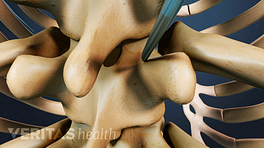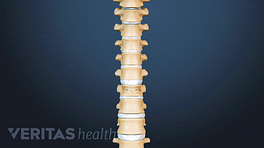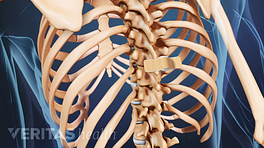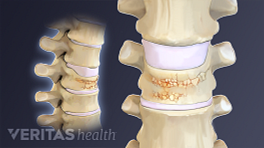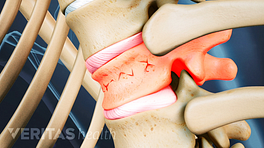Osteoporosis can have a profound effect on the cylinder-shaped bony building blocks that make up the spine, called vertebrae.
Of the 1.5 million people who are diagnosed with an osteoporotic fracture each year, approximately half experience the fracture in their spine, making them twice as common as the next most common fracture site, the hip. 1 American Academy of Orthopaedic Surgeons. Distal Radius Fractures (Broken Wrist). Ortho-Info. March 2013. Available at http://orthoinfo.aaos.org/topic.cfm?topic=A00412. Accessed February 2015.
In This Article:
- Spinal Osteoporosis and Vertebral Fractures: An Overview
- Spinal Osteoporosis and Fracture Risk Factors
- Spinal Osteoporosis Prevention and Treatment
- Osteoporosis Video: Diagnosis and Treatment of Painful Spine Fractures
How Spinal Compression Fractures Occur
Osteoporotic fractures occur due to low bone density and increased bone loss.
While it is possible for other conditions or events to cause a vertebral compression fracture, osteoporosis in the spine is by far the most common cause, especially in women over age 50.
See Who Is at Risk for Osteoporosis?
Osteoporotic spine fractures are the result of bone density loss caused by old bone tissue being resorbed (removed) faster than new bone tissue is being made. As osteoporosis robs the vertebrae of minerals and makes them porous and brittle, the stress and weight these vertebrae have always borne can now crush or break them.
When a patient with osteoporosis breaks a wrist, hip, or other bone outside the spine, it is usually the result of a fall. 1 American Academy of Orthopaedic Surgeons. Distal Radius Fractures (Broken Wrist). Ortho-Info. March 2013. Available at http://orthoinfo.aaos.org/topic.cfm?topic=A00412. Accessed February 2015. , 2 Osteoporosis. Cedars-Sinai. Available at http://www.cedars-sinai.edu/Patients/Health-Conditions/Osteoporosis.aspx. Accessed February 2015. In the spine, however, many osteoporotic fractures are not the result of trauma. In a weakened spine, a fracture may occur while one is sleeping, standing, bending, or twisting, or with a minimal amount of trauma, such as a jolt to the spine when one slips but does not fall.
When osteoporosis causes a vertebra to fracture, it is called a compression fracture. The weakened bone compresses, or collapses in on itself, under the pressure placed on it by the body.
See Osteoporosis: The Primary Cause of Collapsed Vertebrae
Osteoporotic fractures are most common in the lower portion of the thoracic spine 3 Lumbar Compression Fractures: A Patient's Guide to Compression Fracture. University of Maryland Medical Center. July 3, 2013. Available at http://umm.edu/programs/spine/health/guides/lumbar-compression-fractures. Accessed February 2015. (middle back), which bears considerable weight and stress. Osteoporotic fractures are uncommon in the cervical spine, which only bears the weight of the head.
- 1 American Academy of Orthopaedic Surgeons. Distal Radius Fractures (Broken Wrist). Ortho-Info. March 2013. Available at http://orthoinfo.aaos.org/topic.cfm?topic=A00412. Accessed February 2015.
- 2 Osteoporosis. Cedars-Sinai. Available at http://www.cedars-sinai.edu/Patients/Health-Conditions/Osteoporosis.aspx. Accessed February 2015.
- 3 Lumbar Compression Fractures: A Patient's Guide to Compression Fracture. University of Maryland Medical Center. July 3, 2013. Available at http://umm.edu/programs/spine/health/guides/lumbar-compression-fractures. Accessed February 2015.


